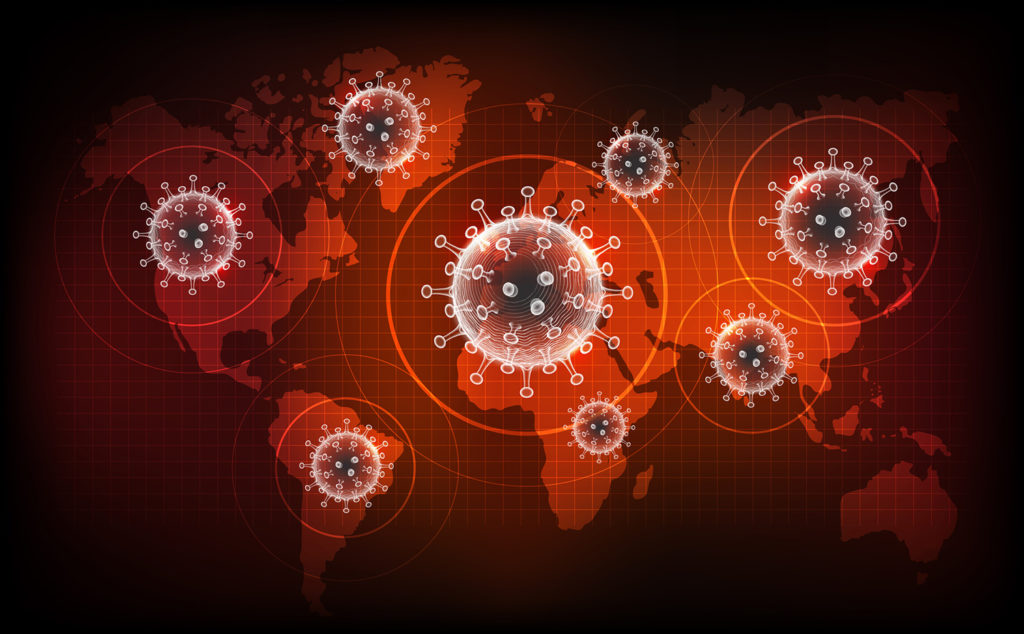Belokamenka is a rural community in the Russian arctic with a permanent population of just 85 people. The locality is hundreds of miles from anything resembling a city and is one of the last places you would expect a major outbreak of COVID-19. And yet in late April, more than 200 temporary residents — workers on a liquid natural gas supply facility construction site — were diagnosed with the disease. The outbreak spread quickly throughout the 600 acre construction site in large part because of the crowded living conditions of the workers and the total lack of any social distancing measures. But how did the virus manage to get to such a remote location in the first place? How did a disease that was originally diagnosed in Wuhan, China manage to make it to the farthest reaches of the globe in such a short period of time, despite all efforts to contain it? The answer is simple: the disease spread so quickly — quicker than any previous virus — by following the very same circuits that connect the global just-in-time supply chain, a chain that is powered by the kind of cheap energy that the Belokamenka facility makes possible and the kind of cheap immigrant labor needed to build such a facility. While human viruses have often followed the flow of commodities — the bubonic plague, for instance, traveled along trade routes for years — the speed and massive scale of globalized capitalism has produced a scenario in which disease can spread across the entire planet in just a matter of weeks. In this respect, COVID-19 is the first great pandemic of the age of global capitalism.
However, as Kim Moody explains, the very same circuits that have allowed both products and diseases to travel across the globe at lightning speed are only made possible by the highly-exploited labor of millions of logistics workers across a handful of companies, and these circuits are thus extremely vulnerable to disruption. As Moody explains:
Three decades of streamlining and refining the movement of goods along tech-enhanced but labor-intensive supply chains have accelerated the speed of disease transmission as well as of commodities and money. But the very speed of these taut arteries of commerce has also increased their vulnerability to disruption.
The competitive value that these supply chains provide is almost entirely dependent upon their ability to get commodities and raw materials where they need to be exactly when they are needed. Any minor disruption along the way can throw the whole process into chaos and cost companies millions or tens of millions of dollars a day in expenses or lost profits. For Moody, the lesson here is obvious. Capitalism’s drive toward efficiency and its attempts to squeeze value out of every minute of the process of production and distribution, mean that workers in the industries that make these supply chains possible (not to mention those who work in high value-added production near logistics hubs and those who help produce and maintain the logistics infrastructure) have an enormous amount of potential leverage. In effect, the nature of the global supply chain shows that despite all of the advanced technology behind global capitalism, it is still working people who make the world run, and it is working people who have the power to shut it down.
Not surprisingly, these essential workers, those who toil in or help to support the many tendrils of the global supply chain, are also some of the most vulnerable. While millions of working people have been laid off and thrown into poverty, those still on the frontlines of distribution, transport, and food and energy production are being forced to take the greatest risks often with the fewest protections. The migrant workers at Belokamenka, for instance, had no personal protective equipment, no gloves, masks, or antiseptics. In the U.S., distribution center and delivery personnel are forced to work in facilities where the virus has already been detected, often without adequate personal protective equipment. Meanwhile, food processing workers across the country, particularly in meat and poultry factories, have seen rates of infection above 50% in some workplaces. Many of these frontline workers are poor people of color and immigrants who are living paycheck to paycheck and cannot afford to take time off to quarantine. Undocumented workers in particular, because they are receiving no relief from the “stimulus package,” are not eligible for unemployment, and are subject to deportation at any moment, are effectively forced to work in unsafe conditions or face economic ruin.
Class Struggle in the Pandemic
In response to these dire conditions, frontline workers across the country, those still on the job, have been rising up to protect their lives and their livelihoods. According to Payday Report, there have been more than 190 wildcat strikes across the country since early March. Many of these work actions and strikes have been in industries vital to the production and distribution of basic goods. From warehouse and factory workers to nursing home attendants, carpenters, grocery store clerks, and delivery persons, workers have led strikes, walkouts, and sickouts demanding everything from safer workplace conditions and protective personal equipment to paid sick leave, hazard pay, and higher wages. In Massachusetts, for instance, 13,000 carpenters refused to work because of unsafe conditions caused by the virus. General Electric workers in Massachusetts also protested in support of producing much-needed ventilators, demonstrating that workers have solutions to the pandemic. In California, hundreds of fast food workers went on strike for hazard pay and paid sick leave, while in Nebraska, meat cutters at a Smithfield pork processing plant walked out in defiance of President Trump’s call to force meatpacking factories to remain open after fifty of their co-workers tested positive for COVID-19. On May Day, workers at some of the largest logistics and delivery companies in the country, including Amazon, Whole Foods, and Target, called for industry-wide strikes, and though unsuccessful (they turned out to be more like protests than strikes), these demonstrations nonetheless show that many workers are increasingly open to collective action and ready for a fight.
In addition to workplace actions such as these, other workers across the country, including many healthcare workers, have been organizing in defense of the most oppressed. At hospitals across the country, nurses have protested to demand adequate personal protective equipment (PPE) and have even joined ranks with striking frontline warehouse workers at Amazon, as well as with other essential workers and communities of color most affected by the crisis. Meanwhile, many other employed and unemployed workers have been tirelessly building movements for a mass rent strike and for the release of incarcerated workers trapped in overcrowded and unsafe immigrant detention centers and prisons. This is the case with the tenant strikes to freeze rents or the Free Them All movement for the closure of migrant detention centers and the abolition of prisons, respectively.
Like the May Day strikes, most of these actions have been illegal or wildcat strikes, often at non-unionized workplaces where there is no bureaucratic leadership to hold them back. They have also been mostly defensive in nature, focused on health, safety, sick leave, and wage protection during the pandemic. And, with the exception of the May Day strikes, which to some extent were coordinated across the grocery and food delivery industry, most have been limited to this or that workplace. While the sheer number of strikes is certainly historic, much of this struggle has been largely spontaneous, led by a small sector of the more advanced workers, and is still nowhere near the mass struggle needed to win real gains for entire industries, much less the class as a whole. Indeed, while the pandemic has considerably increased class struggle among so-called “essential” workers, it has also exacerbated and thrown into stark relief the already existing divisions within the working class more broadly.
The nature of the pandemic and the quarantine have split the working class into several sectors. On the one hand, there are the millions of workers who are able to safely work from home with — at least for the time being — minimal economic or social disruption. On the other hand, there are those essential workers, many of them in logistics, production, and delivery, who have little choice but to continue to work, making it possible for others to remain sheltered in place. This second group, of course, also includes frontline healthcare workers, nurses, and doctors who are more economically secure but often more vulnerable to infection. But there is also a third group of workers: the unemployed. As of last Thursday, more than 33 million workers have applied for unemployment insurance since March. While huge, this number does not even include those who do not qualify, such as the millions of immigrant workers who have been laid off by the restaurant industry or those who were not able to apply because state unemployment offices are so overburdened with applications.
Capital, of course, has always sought to divide the working class. By privileging certain workers (often along racial lines) and by maintaining a reserve army of surplus labor whose sheer poverty operates as a warning to other workers and whose desperation for work drives down wages and limits struggle, capital weakens the collective power of the class. But the pandemic and the resulting economic fallout have exacerbated these divisions. At the same time, though, the crisis has made the collective power of the working class more obvious than ever. The challenge before us, then, is this: how do we connect the struggles of the workers currently in motion (especially precarious frontline workers) to the struggles and interests of the whole class, including those currently without employment? And how do we use this unity to build a class capable of fighting for and winning socialism and building the framework for a communist future?
The Obstacle of the Labor Bureaucracy
While it is seductive to see the spontaneous nature of the current class struggle as a repudiation of the necessity of organized labor for large scale class struggle, the fact remains that any coordinated action capable of building the strength of the working class is impossible without the mass organizational capacity of the national labor unions and their affiliates. Unfortunately, the conservative nature of union leadership means that any such collective action will be unlikely without a direct confrontation with the labor bureaucracy. Indeed, with some notable exceptions, so far most of the big national unions, including the United Auto Workers, the Teamsters, the American Federation of Teachers, and the Service Employees International Union, have been content to negotiate the terms of the quarantine through the usual processes of collective bargaining, lobbying, and closed door deals between union executives, management, and state and federal governments. For instance, the International Trade Union Confederation (ITUC), to which the AFL-CIO belongs, has called for what it calls “social dialogue” and coordination between “unions, employers and governments,” claiming that such coordination is the only way to ensure that people “retain trust in their governments” and guarantee “a post-pandemic future that leaves no one behind.” Such language clearly shows the degree to which the entire apparatus of the labor bureaucracy is little more than a junior partner to capital.
However, this crisis is unlike any we have seen before. The coming economic collapse and the harsh austerity that will likely follow are precisely the kinds of events capable of pushing labor unions to the left. It is quite likely, for instance, that unions are going to face enormous pressures to give concessions in the wake of the pandemic. State and federal cuts to education and public services in particular will hit the public sector workforce especially hard — and the public sector is by far the biggest sector of unionized workers in the country. To defend against the existential threat of such attacks, unions will almost certainly be forced to take stronger positions and advocate more radical defensive actions in the coming period.
And this is where the rank and file comes in. If unions are going to survive this crisis, they will need to be pushed by their members to commit to broader, more confrontational struggles against the state that include fighting on behalf of the class as a whole. The rank and file of the unions has to demand that union leaders break their truce with the government and the corporations and reforge their organizations into weapons of class struggle. This means fighting for health, safety, and economic protections for all workers, whether unionized or not, including the unemployed. But it also means that unions must take up the struggle against the racist attacks that Black and Latinx communities are suffering and develop a plan of struggle for workers’ organizations to take the lead in fighting for the defense of Black and Latinx people.
Such actions, though not seen in the U.S. for many decades, have already been happening across the globe, and there is no reason they can’t happen here. In France, national unions and yellow vest protesters came together to fight alongside the entire working class to protect national pensions. In Chile and Colombia, unions marched alongside non-unionized workers, the unemployed, and students to defy their national governments and win much needed reforms. And more recently, unions in Italy helped organize a mass general strike to shut down non-essential production. Meanwhile the U.S, has already seen rumblings of such actions in the massive teachers strikes of 2018 and 2019. If these strikes are any indication of the fighting spirit of the U.S. working class, then we can expect to continue to see increasing class struggle as workers slowly begin to return to their workplaces.
The Necessity of the United Front
Despite increasing levels of class struggle, the epidemic has taken a heavy toll on the working class, which is currently being devastated by unemployment. And unfortunately, the worst is likely still to come. For this reason, working people need to form a collective defensive response to address the crisis. In order to take advantage of the weakness of capital’s supply chains and the rising wave of spontaneous class struggle — which is sure to increase as workers slowly begin to return to their workplaces — revolutionary socialists and working people must agitate for broad class unity, including unionized and non-unionized workers, undocumented workers, incarcerated workers, and the unemployed, in order to confront the power of the bosses and the state. On their own, unions may be able to win this or that small demand within their own workplaces, but such gains are easily eroded elsewhere. Logistics and production workers, as Moody suggests, even those without unions, may have leverage to win higher wages or greater job security, but without a united working class, they will still face oppression and exploitation in their day to day lives. The decades-long attack on public services and the skyrocketing costs of healthcare, medicine, education, and rent are just a few examples of the ways that even well-paid working people continue to be bled dry outside the workplace. In the case of community organizations, it is auspicious that they are mobilizing for the rights of the urban poor, Black, and Latinx communities, but local gains can also be easily overturned, and a unified class-wide response is required to impose a rent freeze on the government and win all the rights of the Black and Latinx working class who continue to suffer from the poverty and racism of the state and the violence of the white vigilantes supported by Donald Trump.
Any strategy to win the greatest possible unity of the workers to defend themselves from capitalist attacks — in this case exacerbated by the pandemic and the danger of economic depression — must include the tactic of the workers’ united front. Although the unions are key to promoting this unity, the true task of the united front is to organize all the sectors of the working class, including those that are not already organized. This doesn’t mean just organizing new unions or recruiting more workers into the traditional unions, but also finding creative ways to reach larger sectors of the working class, particularly the vast army of unemployed and underemployed that is growing every day in the heat of the crisis. To do this it will be, at least in part, necessary to recover the lessons of the labor movement of the 1930s. When the Great Depression pushed the working class into the abyss, they began to establish unemployment councils promoted by the Trade Union Unity League (TUUL) — an organization created by the American Communist Party (CP). This example spread to other groups, and organizations and councils emerged in Chicago, Seattle, Ohio, West Virginia, and Pennsylvania.
In addition to the creation of such organizations of the unemployed, building a united front of working people in the time of the coronavirus means concretely organizing unions and community, social, and political organizations that represent the interest of the working class, (note: this does not include the Democratic Party) around a national plan of struggle and a unified set of demands. Such a platform would need to include: shutting down non-essential industries, nationalizing the health care system under workers’ control, curbing unemployment, converting production to combat the crisis, freezing the payment of all rents, and creating committees of workers’ self-defense against racist attacks and police brutality against people of color. However, these demands cannot just be delivered from on high any more than a general strike can be called by the decree of Left intellectuals; it has to be developed and fought for through discussion and political struggle across all sectors of the class.
The Tasks of the Socialists
In order to help build the united front, socialists in trade unions, communities, and workplaces have to fight for this perspective. The urgent task of the socialists in the labor movement is to ensure the greatest possible unity of the working ranks by pushing the labor bureaucracy to move beyond their own interests and to align themselves with the interests of the class more broadly. But our goal does not end there. Our task is to expand the influence of socialists in the labor movement and the social movements in order to contest the leaderships of reformism and of the trade union bureaucracy. That said, we do not seek a unity that simply leaves the misleaders of the working class, the reformists, and union bureaucrats in control. We want the kind of unity that raises the consciousness and expectations of working people to move beyond what their leaders will currently allow. As Leon Trotsky said: “The moment the reformists begin to put the brakes on the struggle to the detriment of the movement and to act against the situation and the will of the masses, we, as an independent organization, will always reserve the right to lead the struggle to the end, even without our temporary semi-alliances” (Trotsky, 1921).
While some sectors of the Left have claimed that Democratic Party campaigns like Sanders’s 2016 and 2020 primary contests could be used to unite the working class, such tactics inevitably have the opposite effect. Even with a $200 million war chest, collected almost exclusively from working class donors, Sanders’s campaign failed, leaving those working class donors tied to the very same party as their exploiters. What we need instead is an independent working-class party that fights for socialism. In this sense, the united front as a tactic also has a strategic element, which is to open the way for the emergence of a new leadership capable of moving whole sectors of the class toward revolutionary militancy. At the same time, the struggle for the united front also allows socialists to influence the working class, to break its trust in bourgeois democracy, the bosses, the government, and all the capitalist parties, and to begin to embrace the political class independence that we need to win a socialist world.












